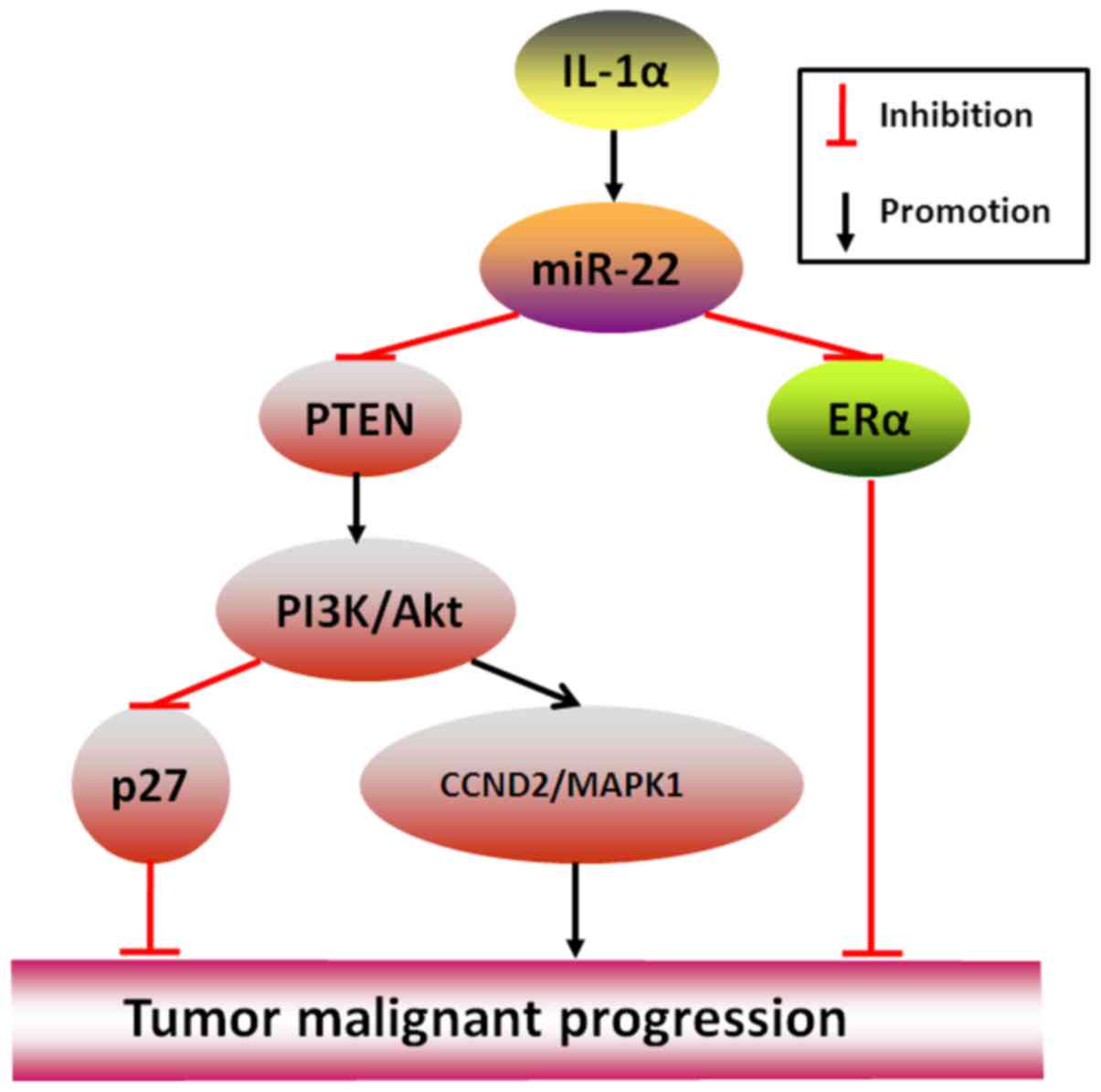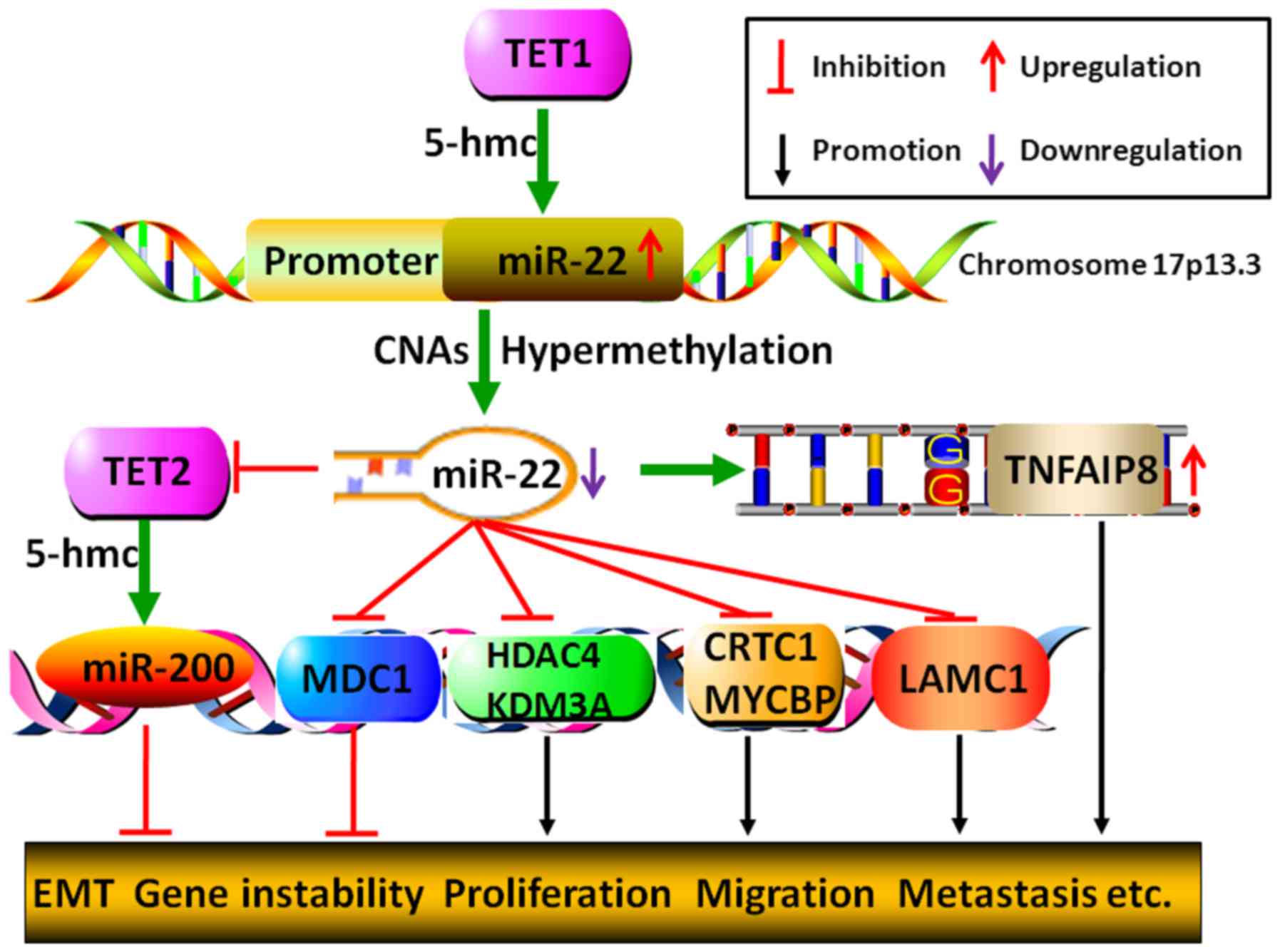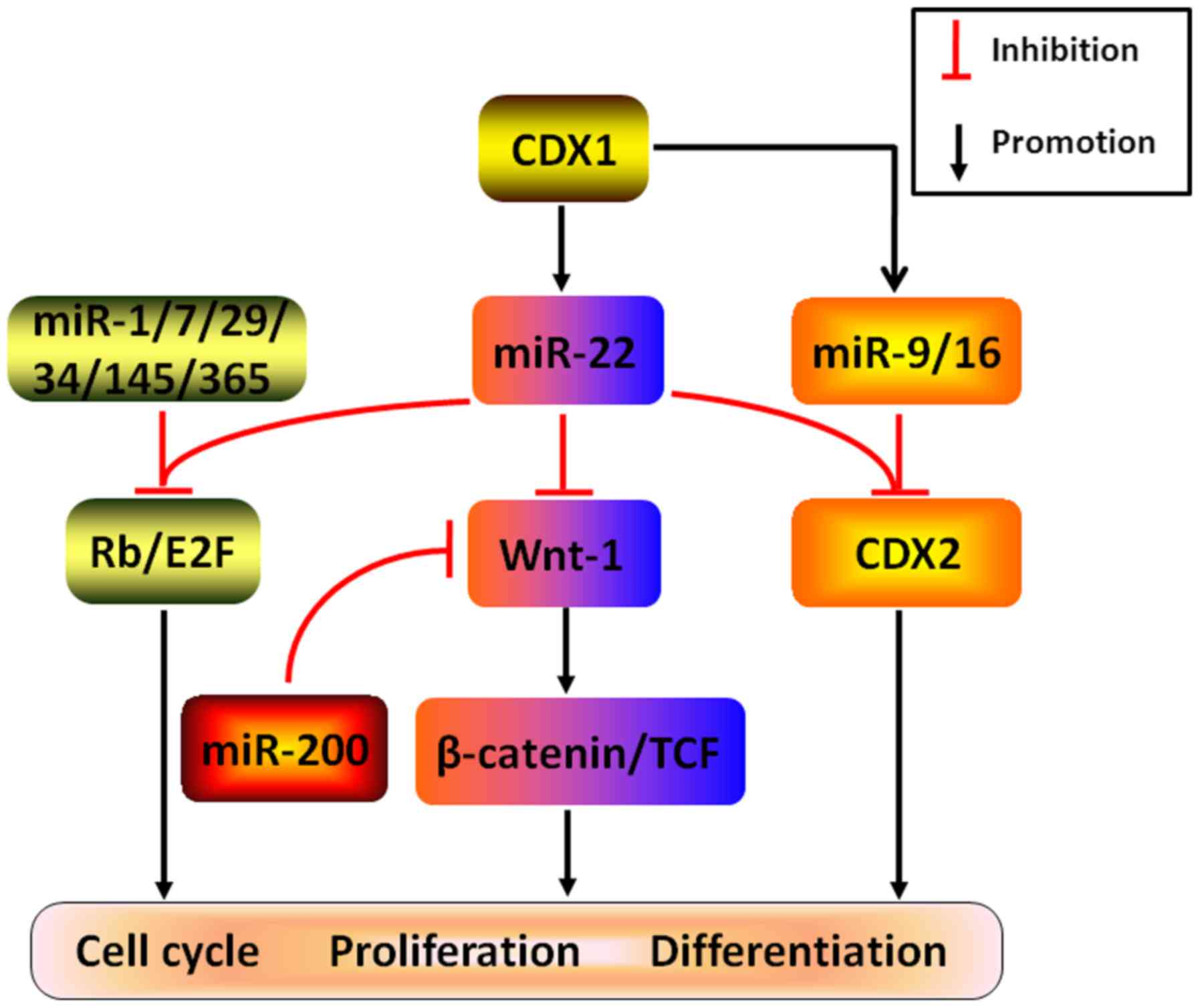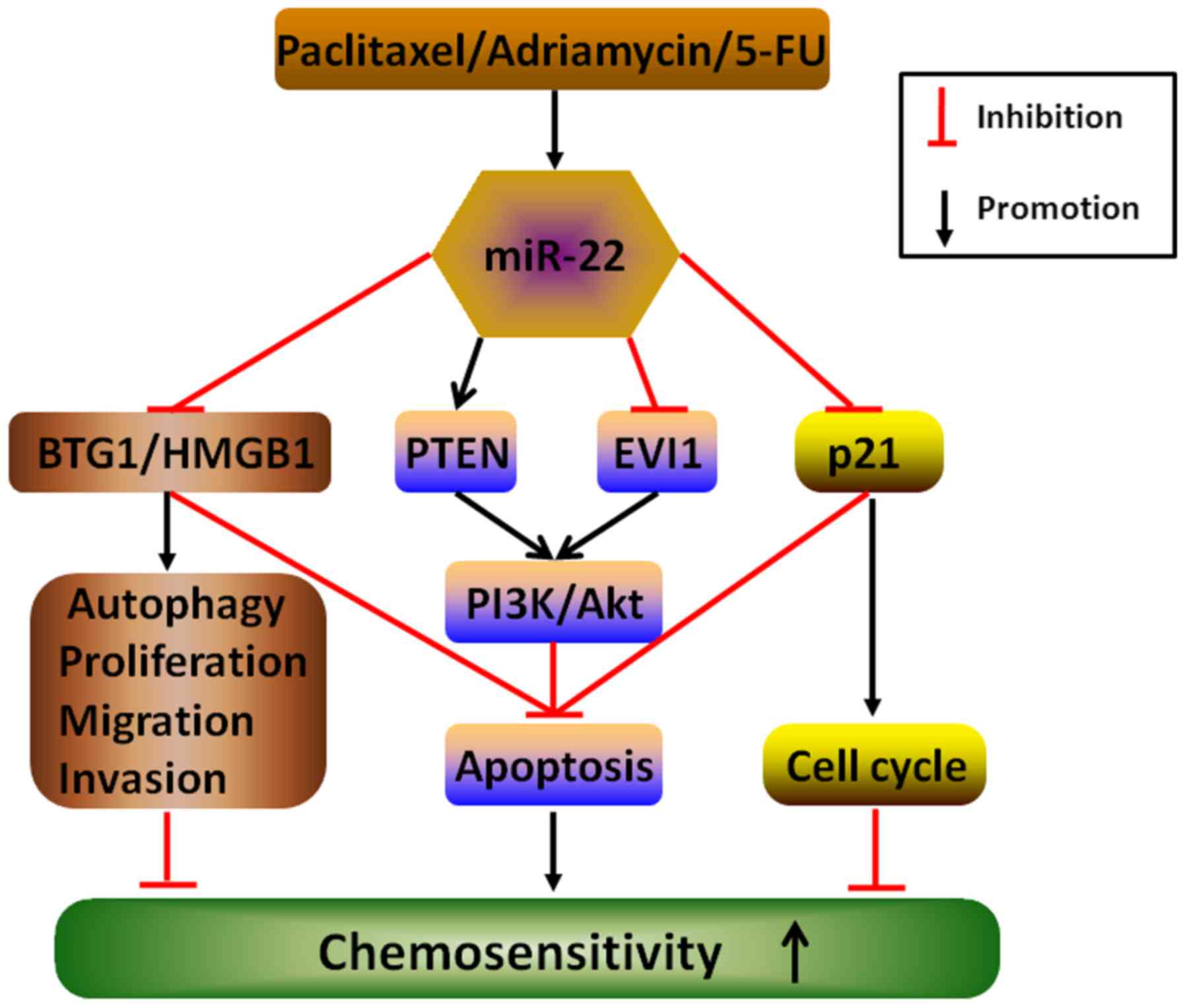Molecular mechanisms and clinical applications of miR-22 in regulating malignant progression in human cancer (Review)
- Authors:
- Jingyu Wang
- Yuan Li
- Meiman Ding
- Honghe Zhang
- Xiaoming Xu
- Jinlong Tang
-
Affiliations: Department of Pathology, The First Hospital of Jiaxing, Zhejiang, P.R. China, Department of Pediatrics, The Affiliated Children's Hospital, Zhejiang University School of Medicine, Hangzhou, P.R. China, The Criminal Investigation Detachment of Jiaxing Public Security Bureau, Hangzhou, Zhejiang, P.R. China, Department of Pathology, Key Laboratory of Disease Proteomics of Zhejiang Province, Zhejiang University School of Medicine, Hangzhou, Zhejiang, P.R. China, Department of Pathology, The Second Affiliated Hospital, Zhejiang University School of Medicine, Hangzhou, Zhejiang, P.R. China - Published online on: December 19, 2016 https://doi.org/10.3892/ijo.2016.3811
- Pages: 345-355
-
Copyright: © Wang et al. This is an open access article distributed under the terms of Creative Commons Attribution License.
This article is mentioned in:
Abstract
 |
 |
 |
 |
 |
 |
 |
|
Lagos-Quintana M, Rauhut R, Lendeckel W and Tuschl T: Identification of novel genes coding for small expressed RNAs. Science. 294:853–858. 2001. View Article : Google Scholar : PubMed/NCBI | |
|
Knyazev EN, Samatov TR, Fomicheva KA, Nyushko KM, Alekseev BY and Shkurnikov MY: MicroRNA hsa-miR-4674 in hemolysis-free blood plasma is associated with distant metastases of prostatic cancer. Bull Exp Biol Med. 161:112–115. 2016. View Article : Google Scholar : PubMed/NCBI | |
|
Yang C, Ning S, Li Z, Qin X and Xu W: miR-22 is down-regulated in esophageal squamous cell carcinoma and inhibits cell migration and invasion. Cancer Cell Int. 14:1382014. View Article : Google Scholar : PubMed/NCBI | |
|
Damavandi Z, Torkashvand S, Vasei M, Soltani BM, Tavallaei M and Mowla SJ: Aberrant expression of breast development-related microRNAs, miR-22, miR-132, and miR-212, in breast tumor tissues. J Breast Cancer. 19:148–155. 2016. View Article : Google Scholar : PubMed/NCBI | |
|
Yang M, Jiang N, Cao QW and Sun Q: EDD1 predicts prognosis and regulates gastric cancer growth in vitro and in vivo via miR-22. Biol Chem. Apr 28–2016.Epub ahead of print. View Article : Google Scholar | |
|
Bar N and Dikstein R: miR-22 forms a regulatory loop in PTEN/AKT pathway and modulates signaling kinetics. PLoS One. 5:e108592010. View Article : Google Scholar : PubMed/NCBI | |
|
Budd WT, Seashols-Williams SJ, Clark GC, Weaver D, Calvert V, Petricoin E, Dragoescu EA, O'Hanlon K and Zehner ZE: Dual action of miR-125b as a tumor suppressor and oncomiR-22 promotes prostate cancer tumorigenesis. PLoS One. 10:e01423732015. View Article : Google Scholar : PubMed/NCBI | |
|
Xu D, Takeshita F, Hino Y, Fukunaga S, Kudo Y, Tamaki A, Matsunaga J, Takahashi RU, Takata T, Shimamoto A, et al: miR-22 represses cancer progression by inducing cellular senescence. J Cell Biol. 193:409–424. 2011. View Article : Google Scholar : PubMed/NCBI | |
|
Pasqualini L, Bu H, Puhr M, Narisu N, Rainer J, Schlick B, Schäfer G, Angelova M, Trajanoski Z, Börno ST, et al: miR-22 and miR-29a are members of the androgen receptor cistrome modulating LAMC1 and Mcl-1 in prostate cancer. Mol Endocrinol. 29:1037–1054. 2015. View Article : Google Scholar : PubMed/NCBI | |
|
Chen B, Tang H, Liu X, Liu P, Yang L, Xie X, Ye F, Song C, Xie X and Wei W: miR-22 as a prognostic factor targets glucose transporter protein type 1 in breast cancer. Cancer Lett. 356:410–417. 2015. View Article : Google Scholar | |
|
Xin M, Qiao Z, Li J, Liu J, Song S, Zhao X, Miao P, Tang T, Wang L, Liu W, et al: miR-22 inhibits tumor growth and metastasis by targeting ATP citrate lyase: Evidence in osteosarcoma, prostate cancer, cervical cancer and lung cancer. Oncotarget. 7:44252–44265. 2016.PubMed/NCBI | |
|
Yamakuchi M, Yagi S, Ito T and Lowenstein CJ: MicroRNA-22 regulates hypoxia signaling in colon cancer cells. PLoS One. 6:e202912011. View Article : Google Scholar : PubMed/NCBI | |
|
Yang F, Hu Y, Liu HX and Wan YJ: miR-22-silenced cyclin A expression in colon and liver cancer cells is regulated by bile acid receptor. J Biol Chem. 290:6507–6515. 2015. View Article : Google Scholar : PubMed/NCBI | |
|
Shi C and Xu X: MicroRNA-22 is down-regulated in hepatitis B virus-related hepatocellular carcinoma. Biomed Pharmacother. 67:375–380. 2013. View Article : Google Scholar : PubMed/NCBI | |
|
Li S, Hu R, Wang C, Guo F, Li X and Wang S: miR-22 inhibits proliferation and invasion in estrogen receptor α-positive endometrial endometrioid carcinomas cells. Mol Med Rep. 9:2393–2399. 2014.PubMed/NCBI | |
|
Ting Y, Medina DJ, Strair RK and Schaar DG: Differentiation-associated miR-22 represses Max expression and inhibits cell cycle progression. Biochem Biophys Res Commun. 394:606–611. 2010. View Article : Google Scholar : PubMed/NCBI | |
|
Alvarez-Díaz S, Valle N, Ferrer-Mayorga G, Lombardía L, Herrera M, Domínguez O, Segura MF, Bonilla F, Hernando E and Muñoz A: MicroRNA-22 is induced by vitamin D and contributes to its antiproliferative, antimigratory and gene regulatory effects in colon cancer cells. Hum Mol Genet. 21:2157–2165. 2012. View Article : Google Scholar : PubMed/NCBI | |
|
Pandey DP and Picard D: miR-22 inhibits estrogen signaling by directly targeting the estrogen receptor alpha mRNA. Mol Cell Biol. 29:3783–3790. 2009. View Article : Google Scholar : PubMed/NCBI | |
|
Wang X, Yu H, Lu X, Zhang P, Wang M and Hu Y: miR-22 suppresses the proliferation and invasion of gastric cancer cells by inhibiting CD151. Biochem Biophys Res Commun. 445:175–179. 2014. View Article : Google Scholar : PubMed/NCBI | |
|
Tang Y, Liu X, Su B, Zhang Z, Zeng X, Lei Y, Shan J, Wu Y, Tang H and Su Q: microRNA-22 acts as a metastasis suppressor by targeting metadherin in gastric cancer. Mol Med Rep. 11:454–460. 2015. | |
|
Yang Q, Jiang W, Zhuang C, Geng Z, Hou C, Huang D, Hu L and Wang X: microRNA-22 downregulation of galectin-9 influences lymphocyte apoptosis and tumor cell proliferation in liver cancer. Oncol Rep. 34:1771–1778. 2015.PubMed/NCBI | |
|
Ahmad HM, Muiwo P, Ramachandran SS, Pandey P, Gupta YK, Kumar L, Kulshreshtha R and Bhattacharya A: miR-22 regulates expression of oncogenic neuroepithelial transforming gene 1, NET1. FEBS J. 281:3904–3919. 2014. View Article : Google Scholar : PubMed/NCBI | |
|
Xu QF, Pan YW, Li LC, Zhou Z, Huang QL, Pang JC, Zhu XP, Ren Y, Yang H, Ohgaki H, et al: miR-22 is frequently downregulated in medulloblastomas and inhibits cell proliferation via the novel target PAPST1. Brain Pathol. 24:568–583. 2014. View Article : Google Scholar : PubMed/NCBI | |
|
Sreenivasan S, Thirumalai K, Danda R and Krishnakumar S: Effect of curcumin on miRNA expression in human Y79 retinoblastoma cells. Curr Eye Res. 37:421–428. 2012. View Article : Google Scholar : PubMed/NCBI | |
|
Ling B, Wang GX, Long G, Qiu JH and Hu ZL: Tumor suppressor miR-22 suppresses lung cancer cell progression through post-transcriptional regulation of ErbB3. J Cancer Res Clin Oncol. 138:1355–1361. 2012. View Article : Google Scholar : PubMed/NCBI | |
|
Patel JB, Appaiah HN, Burnett RM, Bhat-Nakshatri P, Wang G, Mehta R, Badve S, Thomson MJ, Hammond S, Steeg P, et al: Control of EVI-1 oncogene expression in metastatic breast cancer cells through microRNA miR-22. Oncogene. 30:1290–1301. 2011. View Article : Google Scholar | |
|
Li J, Liang S, Yu H, Zhang J, Ma D and Lu X: An inhibitory effect of miR-22 on cell migration and invasion in ovarian cancer. Gynecol Oncol. 119:543–548. 2010. View Article : Google Scholar : PubMed/NCBI | |
|
Jiang R, Deng L, Zhao L, Li X, Zhang F, Xia Y, Gao Y, Wang X and Sun B: miR-22 promotes HBV-related hepatocellular carcinoma development in males. Clin Cancer Res. 17:5593–5603. 2011. View Article : Google Scholar : PubMed/NCBI | |
|
Fan W, Huang J, Xiao H and Liang Z: MicroRNA-22 is down-regulated in clear cell renal cell carcinoma, and inhibits cell growth, migration and invasion by targeting PTEN. Mol Med Rep. 13:4800–4806. 2016.PubMed/NCBI | |
|
Palacios F, Abreu C, Prieto D, Morande P, Ruiz S, Fernández-Calero T, Naya H, Libisch G, Robello C, Landoni AI, et al: Activation of the PI3K/AKT pathway by microRNA-22 results in CLL B-cell proliferation. Leukemia. 29:115–125. 2015. View Article : Google Scholar | |
|
Tang J, Li Y, Wang J, Wen Z, Lai M and Zhang H: Molecular mechanisms of microRNAs in regulating epithelial-mesenchymal transitions in human cancers. Cancer Lett. 371:301–313. 2016. View Article : Google Scholar | |
|
Lu M, Jolly MK, Levine H, Onuchic JN and Ben-Jacob E: MicroRNA-based regulation of epithelial-hybrid-mesenchymal fate determination. Proc Natl Acad Sci USA. 110:18144–18149. 2013. View Article : Google Scholar : PubMed/NCBI | |
|
Moes M, Le Béchec A, Crespo I, Laurini C, Halavatyi A, Vetter G, Del Sol A and Friederich E: A novel network integrating a miRNA-203/SNAI1 feedback loop which regulates epithelial to mesenchymal transition. PLoS One. 7:e354402012. View Article : Google Scholar : PubMed/NCBI | |
|
Ding X, Park SI, McCauley LK and Wang CY: Signaling between transforming growth factor β (TGF-β) and transcription factor SNAI2 represses expression of microRNA miR-203 to promote epithelial-mesenchymal transition and tumor metastasis. J Biol Chem. 288:10241–10253. 2013. View Article : Google Scholar : PubMed/NCBI | |
|
Xiong J, Du Q and Liang Z: Tumor-suppressive microRNA-22 inhibits the transcription of E-box-containing c-Myc target genes by silencing c-Myc binding protein. Oncogene. 29:4980–4988. 2010. View Article : Google Scholar : PubMed/NCBI | |
|
Guo MM, Hu LH, Wang YQ, Chen P, Huang JG, Lu N, He JH and Liao CG: miR-22 is down-regulated in gastric cancer, and its overexpression inhibits cell migration and invasion via targeting transcription factor Sp1. Med Oncol. 30:5422013. View Article : Google Scholar : PubMed/NCBI | |
|
Kong LM, Liao CG, Zhang Y, Xu J, Li Y, Huang W, Zhang Y, Bian H and Chen ZN: A regulatory loop involving miR-22, Sp1, and c-Myc modulates CD147 expression in breast cancer invasion and metastasis. Cancer Res. 74:3764–3778. 2014. View Article : Google Scholar : PubMed/NCBI | |
|
Choi JH, Hwang YP, Kim HG, Khanal T, Do MT, Jin SW, Han HJ, Lee HS, Lee YC, Chung YC, et al: Saponins from the roots of Platycodon grandiflorum suppresses TGFβ1-induced epithelial-mesenchymal transition via repression of PI3K/Akt, ERK1/2 and Smad2/3 pathway in human lung carcinoma A549 cells. Nutr Cancer. 66:140–151. 2014. View Article : Google Scholar | |
|
Pandey AK, Zhang Y, Zhang S, Li Y, Tucker-Kellogg G, Yang H and Jha S: TIP60-miR-22 axis as a prognostic marker of breast cancer progression. Oncotarget. 6:41290–41306. 2015.PubMed/NCBI | |
|
Li B, Song Y, Liu TJ, Cui YB, Jiang Y, Xie ZS and Xie SL: miRNA-22 suppresses colon cancer cell migration and invasion by inhibiting the expression of T-cell lymphoma invasion and metastasis 1 and matrix metalloproteinases 2 and 9. Oncol Rep. 29:1932–1938. 2013.PubMed/NCBI | |
|
Zuo QF, Cao LY, Yu T, Gong L, Wang LN, Zhao YL, Xiao B and Zou QM: MicroRNA-22 inhibits tumor growth and metastasis in gastric cancer by directly targeting MMP14 and Snail. Cell Death Dis. 6:e20002015. View Article : Google Scholar : PubMed/NCBI | |
|
Zhang S, Zhang D, Yi C, Wang Y, Wang H and Wang J: MicroRNA-22 functions as a tumor suppressor by targeting SIRT1 in renal cell carcinoma. Oncol Rep. 35:559–567. 2016. | |
|
Su YH, Huang WC, Huang TH, Huang YJ, Sue YK, Huynh TT, Hsiao M, Liu TZ, Wu AT and Lin CM: Folate deficient tumor microenvironment promotes epithelial-to-mesenchymal transition and cancer stem-like phenotypes. Oncotarget. 7:33246–33256. 2016.PubMed/NCBI | |
|
Ninomiya S, Tyybäkinoja A, Borze I, Räty R, Saarinen-Pihkala UM, Usvasalo A, Elonen E and Knuutila S: Integrated analysis of gene copy number, copy neutral LOH, and microRNA profiles in adult acute lymphoblastic leukemia. Cytogenet Genome Res. 136:246–255. 2012. View Article : Google Scholar : PubMed/NCBI | |
|
Shi TY, Cheng X, Yu KD, Sun MH, Shao ZM, Wang MY, Zhu ML, He J, Li QX, Chen XJ, et al: Functional variants in TNFAIP8 associated with cervical cancer susceptibility and clinical outcomes. Carcinogenesis. 34:770–778. 2013. View Article : Google Scholar : PubMed/NCBI | |
|
Zhang J, Yang Y, Yang T, Liu Y, Li A, Fu S, Wu M, Pan Z and Zhou W: microRNA-22, downregulated in hepatocellular carcinoma and correlated with prognosis, suppresses cell proliferation and tumourigenicity. Br J Cancer. 103:1215–1220. 2010. View Article : Google Scholar : PubMed/NCBI | |
|
Parrish JK, Sechler M, Winn RA and Jedlicka P: The histone demethylase KDM3A is a microRNA-22-regulated tumor promoter in Ewing Sarcoma. Oncogene. 34:257–262. 2015. View Article : Google Scholar : | |
|
Lee JH, Park SJ, Jeong SY, Kim MJ, Jun S, Lee HS, Chang IY, Lim SC, Yoon SP, Yong J, et al: MicroRNA-22 suppresses DNA repair and promotes genomic instability through targeting of MDC1. Cancer Res. 75:1298–1310. 2015. View Article : Google Scholar : PubMed/NCBI | |
|
Madzo J, Liu H, Rodriguez A, Vasanthakumar A, Sundaravel S, Caces DB, Looney TJ, Zhang L, Lepore JB, Macrae T, et al: Hydroxymethylation at gene regulatory regions directs stem/early progenitor cell commitment during erythropoiesis. Cell Rep. 6:231–244. 2014. View Article : Google Scholar : PubMed/NCBI | |
|
Shen L, Wu H, Diep D, Yamaguchi S, D'Alessio AC, Fung HL, Zhang K and Zhang Y: Genome-wide analysis reveals TET- and TDG-dependent 5-methylcytosine oxidation dynamics. Cell. 153:692–706. 2013. View Article : Google Scholar : PubMed/NCBI | |
|
Coutinho DF, Monte-Mór BC, Vianna DT, Rouxinol ST, Batalha AB, Bueno AP, Boulhosa AM, Fernandez TS, Pombo-de-Oliveira MS, Gutiyama LM, et al: TET2 expression level and 5-hydroxymethylcytosine are decreased in refractory cytopenia of childhood. Leuk Res. 39:1103–1108. 2015. View Article : Google Scholar : PubMed/NCBI | |
|
Song SJ, Poliseno L, Song MS, Ala U, Webster K, Ng C, Beringer G, Brikbak NJ, Yuan X, Cantley LC, et al: MicroRNA-antagonism regulates breast cancer stemness and metastasis via TET-family-dependent chromatin remodeling. Cell. 154:311–324. 2013. View Article : Google Scholar : PubMed/NCBI | |
|
Song SJ, Ito K, Ala U, Kats L, Webster K, Sun SM, Jongen-Lavrencic M, Manova-Todorova K, Teruya-Feldstein J, Avigan DE, et al: The oncogenic microRNA miR-22 targets the TET2 tumor suppressor to promote hematopoietic stem cell self-renewal and transformation. Cell Stem Cell. 13:87–101. 2013. View Article : Google Scholar : PubMed/NCBI | |
|
Jiang X, Hu C, Arnovitz S, Bugno J, Yu M, Zuo Z, Chen P, Huang H, Ulrich B, Gurbuxani S, et al: miR-22 has a potent anti-tumour role with therapeutic potential in acute myeloid leukemia. Nat Commun. 7:114522016. View Article : Google Scholar | |
|
Tagawa T, Haraguchi T, Hiramatsu H, Kobayashi K, Sakurai K, Inada K and Iba H: Multiple microRNAs induced by Cdx1 suppress Cdx2 in human colorectal tumour cells. Biochem J. 447:449–455. 2012. View Article : Google Scholar : PubMed/NCBI | |
|
Marzi MJ, Puggioni EM, Dall'Olio V, Bucci G, Bernard L, Bianchi F, Crescenzi M, Di Fiore PP and Nicassio F: Differentiation-associated microRNAs antagonize the Rb-E2F pathway to restrict proliferation. J Cell Biol. 199:77–95. 2012. View Article : Google Scholar : PubMed/NCBI | |
|
Tang H, Kong Y, Guo J, Tang Y and Xie X, Yang L, Su Q and Xie X: Diallyl disulfide suppresses proliferation and induces apoptosis in human gastric cancer through Wnt-1 signaling pathway by up-regulation of miR-200b and miR-22. Cancer Lett. 340:72–81. 2013. View Article : Google Scholar : PubMed/NCBI | |
|
Li J, Zhang Y, Zhao J, Kong F and Chen Y: Overexpression of miR-22 reverses paclitaxel-induced chemoresistance through activation of PTEN signaling in p53-mutated colon cancer cells. Mol Cell Biochem. 357:31–38. 2011. View Article : Google Scholar : PubMed/NCBI | |
|
Tsuchiya N, Izumiya M, Ogata-Kawata H, Okamoto K, Fujiwara Y, Nakai M, Okabe A, Schetter AJ, Bowman ED, Midorikawa Y, et al: Tumor suppressor miR-22 determines p53-dependent cellular fate through post-transcriptional regulation of p21. Cancer Res. 71:4628–4639. 2011. View Article : Google Scholar : PubMed/NCBI | |
|
Zhang H, Tang J, Li C, Kong J, Wang J, Wu Y, Xu E and Lai M: miR-22 regulates 5-FU sensitivity by inhibiting autophagy and promoting apoptosis in colorectal cancer cells. Cancer Lett. 356:781–790. 2015. View Article : Google Scholar | |
|
Guo S, Bai R, Liu W, Zhao A, Zhao Z, Wang Y, Wang Y, Zhao W and Wang W: miR-22 inhibits osteosarcoma cell proliferation and migration by targeting HMGB1 and inhibiting HMGB1-mediated autophagy. Tumour Biol. 35:7025–7034. 2014. View Article : Google Scholar : PubMed/NCBI | |
|
Nagaraja AK, Creighton CJ, Yu Z, Zhu H, Gunaratne PH, Reid JG, Olokpa E, Itamochi H, Ueno NT, Hawkins SM, et al: A link between miR-100 and FRAP1/mTOR in clear cell ovarian cancer. Mol Endocrinol. 24:447–463. 2010. View Article : Google Scholar : PubMed/NCBI | |
|
Kawahigashi Y, Mishima T, Mizuguchi Y, Arima Y, Yokomuro S, Kanda T, Ishibashi O, Yoshida H, Tajiri T and Takizawa T: MicroRNA profiling of human intrahepatic cholangiocarcinoma cell lines reveals biliary epithelial cell-specific microRNAs. J Nippon Med Sch. 76:188–197. 2009. View Article : Google Scholar : PubMed/NCBI | |
|
Zekri AN, Youssef AS, El-Desouky ED, Ahmed OS, Lotfy MM, Nassar AA and Bahnassey AA: Serum microRNA panels as potential biomarkers for early detection of hepatocellular carcinoma on top of HCV infection. Tumour Biol. 37:12273–12286. 2016. View Article : Google Scholar : PubMed/NCBI | |
|
Shin YM, Yun J, Lee OJ, Han HS, Lim SN, An JY, Lee KH, Lee KM and Choe KH: Diagnostic value of circulating extracellular miR-134, miR-185, and miR-22 levels in lung adenocarcinoma-associated malignant pleural effusion. Cancer Res Treat. 46:178–185. 2014. View Article : Google Scholar : PubMed/NCBI | |
|
Zhang C, Wang C, Chen X, Yang C, Li K, Wang J, Dai J, Hu Z, Zhou X, Chen L, et al: Expression profile of microRNAs in serum: A fingerprint for esophageal squamous cell carcinoma. Clin Chem. 56:1871–1879. 2010. View Article : Google Scholar : PubMed/NCBI | |
|
Ganepola GA, Rutledge JR, Suman P, Yiengpruksawan A and Chang DH: Novel blood-based microRNA biomarker panel for early diagnosis of pancreatic cancer. World J Gastrointest Oncol. 6:22–33. 2014. View Article : Google Scholar : PubMed/NCBI | |
|
Franchina T, Amodeo V, Bronte G, Savio G, Ricciardi GR, Picciotto M, Russo A, Giordano A and Adamo V: Circulating miR-22, miR-24 and miR-34a as novel predictive biomarkers to pemetrexed-based chemotherapy in advanced non-small cell lung cancer. J Cell Physiol. 229:97–99. 2014. | |
|
Wang W, Li F, Zhang Y, Tu Y, Yang Q and Gao X: Reduced expression of miR-22 in gastric cancer is related to clinicopathologic characteristics or patient prognosis. Diagn Pathol. 8:1022013. View Article : Google Scholar : PubMed/NCBI | |
|
Zhang G, Xia S, Tian H, Liu Z and Zhou T: Clinical significance of miR-22 expression in patients with colorectal cancer. Med Oncol. 29:3108–3112. 2012. View Article : Google Scholar : PubMed/NCBI |









